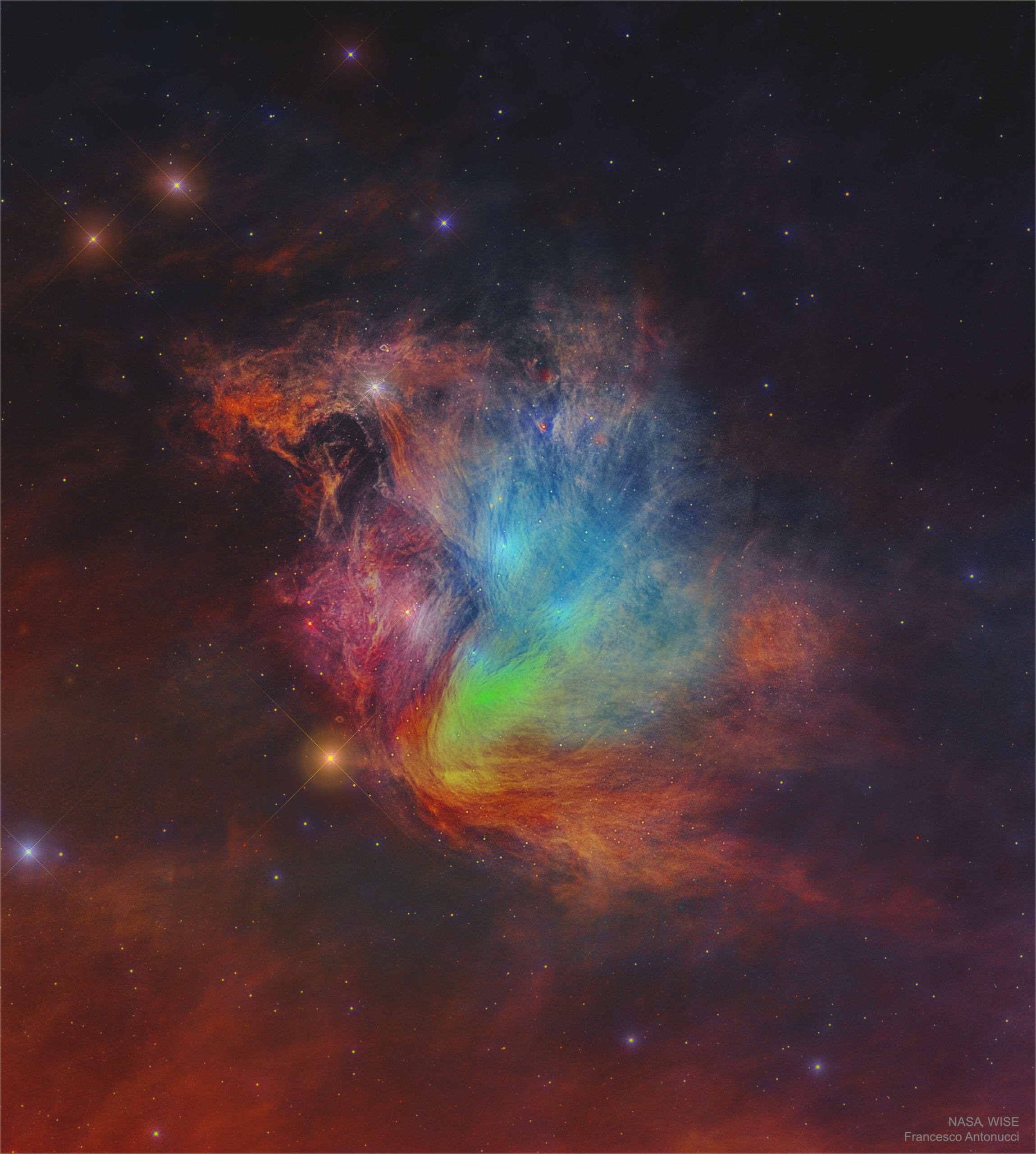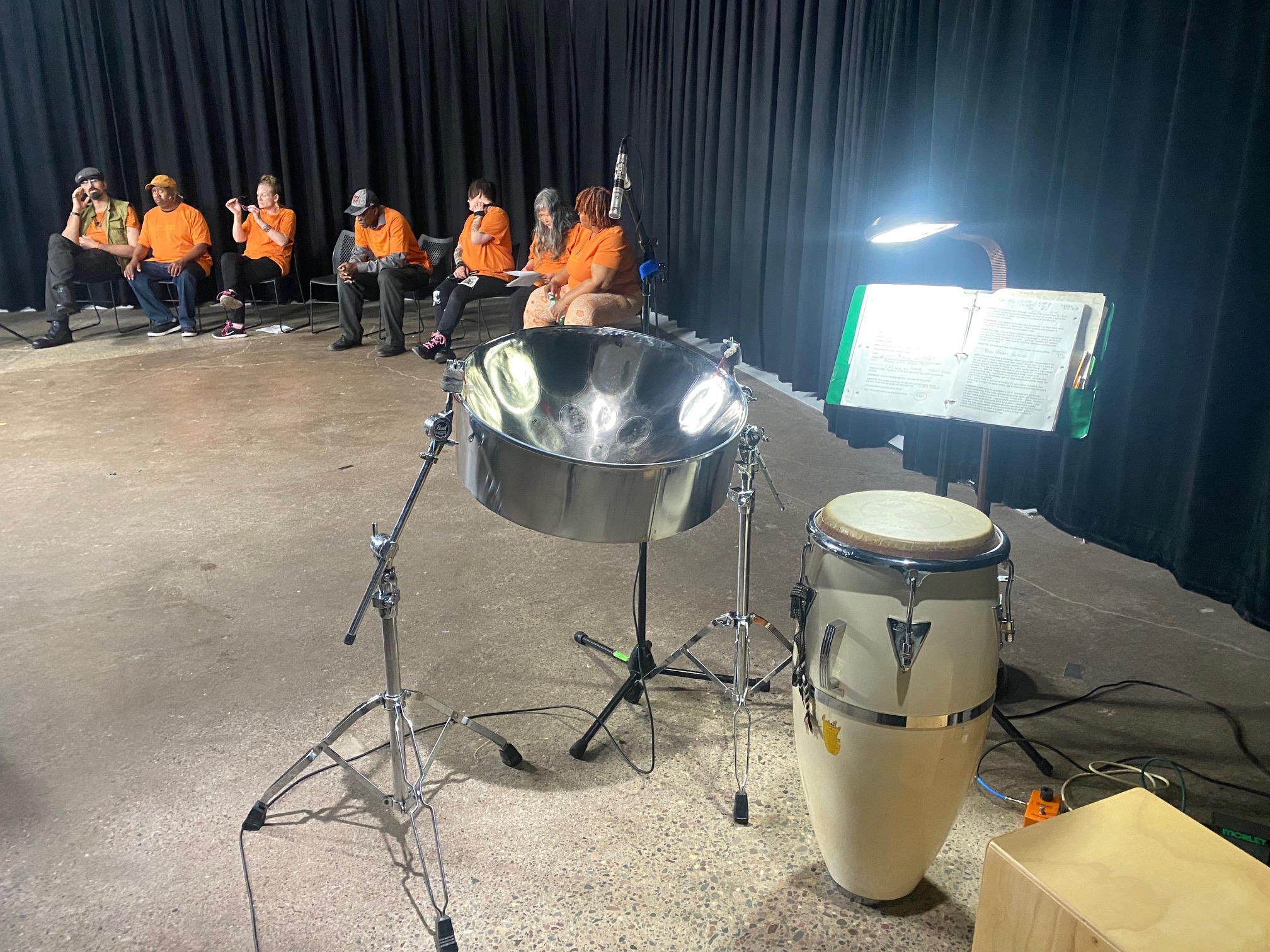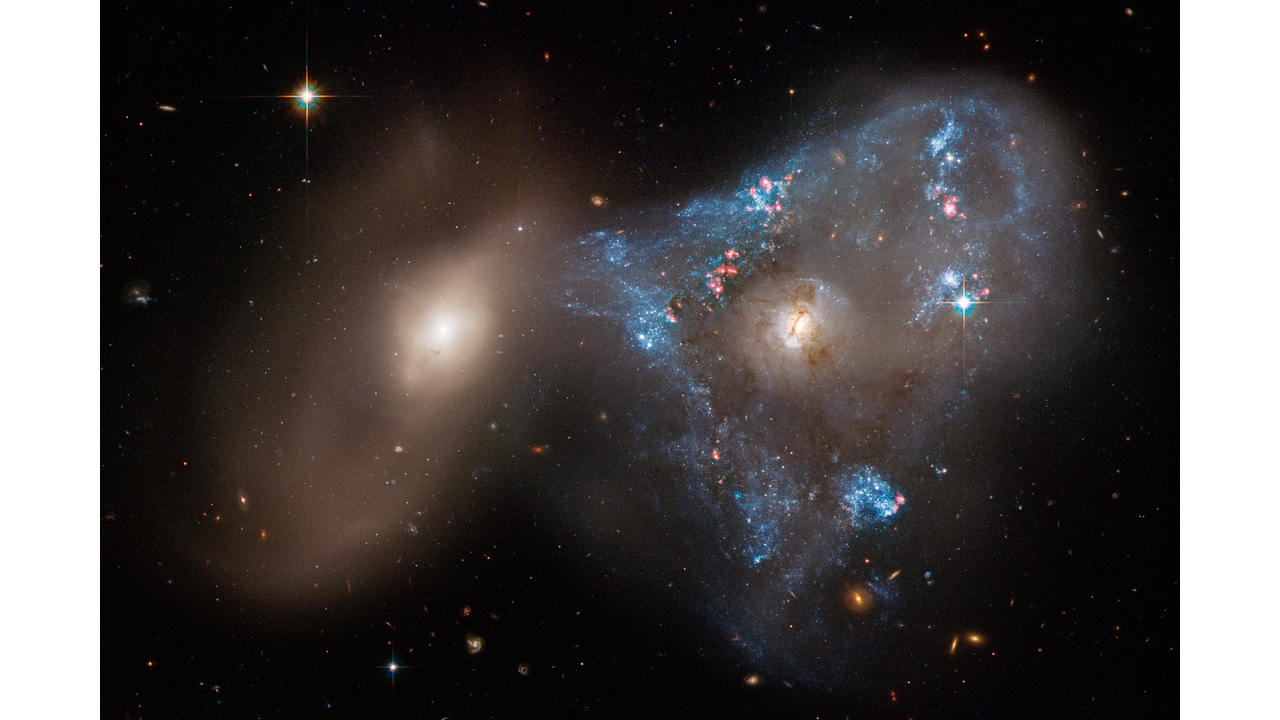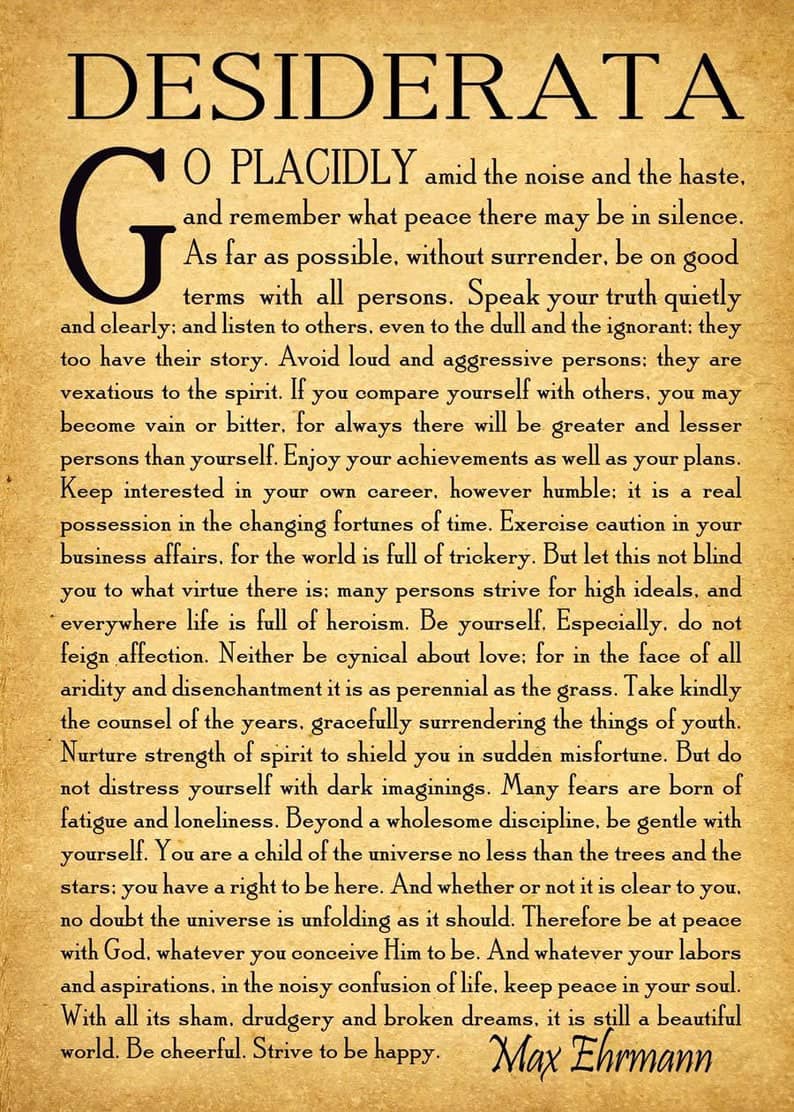Blog
Known for its iconic blue stars, the Pleiades is shown here in infrared light where the surrounding dust outshines the stars. Here, three infrared colors have been mapped into visual colors (R=24, G=12, B=4.6 microns). The base images were taken by NASA’s orbiting Wide Field Infrared Survey Explorer (WISE) spacecraft. Cataloged as M45 and nicknamed the Seven Sisters, the Pleiades star cluster is by chance situated in a passing dust cloud. The light and winds from the massive Pleiades stars preferentially repel smaller dust particles, causing the dust to become stratified into filaments, as seen. The featured image spans about 20 light years at the distance of the Pleiades, which lies about 450 light years distant toward the constellation of the Bull (Taurus).

September 29th 1941-May 15th 1995
Perry Lederman, who died May 15 at his home in Woods Hole, Massachusetts, after a long battle with cancer, was one of the little-known legends of the folk revival. Born in Brooklyn, NY, he was inspired to learn guitar after seeing Tom Paley playing in Washington Square Park and quickly became one of the foremost fingerstyle players in the city, exploring and reviving traditional styles in the company of friends like Danny Kalb and Roy Berkeley. He was also a peerless seeker-out of vintage ¾-size Martin guitars, which he continued to favor throughout his life.
Perry continued to play during a brief college stint in Ann Arbor, Michigan, then moved to Berkeley, California, where he became a leading folk performer in partnership with writer and poet Al Young. His playing, notable for its passion and imagination, and an astonishing, controlled vibrato, was a major influence on later West Coast players like John Fahey and frequent housemate and jamming partner Michael Bloomfield. It was during this period that he made his only issued recording, on a Bay Area sampler for the Arhoolie label. More interested in the music itself than in commercial success, Perry put the guitar aside just as his West Coast followers began to receive national attention, preferring to spend eight years studying sarod as a student and friend of Indian master Ali Akbar Khan.
more...Roy Sinclair Campbell Jr. (September 29, 1952 – January 9, 2014) was an American trumpeter frequently linked to free jazz, although he also performed rhythm and bluesand funk during his career.
Born in Los Angeles, California, in 1952, Campbell was raised in New York City. At the age of fifteen, he began learning to play trumpet and soon studied at the Jazz Mobile program along with Kenny Dorham, Lee Morgan and Joe Newman.Throughout the 1960s, still unacquainted with the avant-garde movement, Campbell performed in the big bands of the Manhattan Community College. From the 1970s onwards, he performed primarily within the context of free jazz, spending some of this period studying with Yusef Lateef. Campbell composed the film music for the documentary Survival in New York (1989) by Rosa von Praunheim.
In the early 1990s, Campbell moved to the Netherlands and performed regularly with Klaas Hekman and Don Cherry. In addition to leading his own groups, he performed with Yo La Tengo, William Parker, Peter Brötzmann, Matthew Shipp, and other improvisors. Upon returning to the United States he began leading his group Other Dimensions In Music and also formed the Pyramid Trio, a pianoless trio formed with William Parker.
He died in January 2014 of hypertensive atherosclerotic cardiovascular disease at the age of 61.
more...Jean-Luc Ponty (born 29 September 1942) is a French jazz and jazz fusion violinist and composer. Ponty was born into a family of classical musicians in Avranches, France. His father taught violin, his mother taught piano. At sixteen, he was admitted to the Conservatoire National Supérieur de Musique de Paris, graduating two years later with the institution’s highest honor, Premier Prix (first prize). He was hired by the Orchestre Lamoureux in which he played for three years.
While still a member of the orchestra in Paris, Ponty picked up a side job playing clarinet (which his father had taught him) for a college jazz band that regularly performed at local parties. It proved life-changing. A growing interest in Miles Davis and John Coltrane compelled him to take up tenor saxophone. One night after an orchestra concert, and still wearing his tuxedo, Ponty found himself at a local club with only his violin. Within four years, he was widely accepted as the leading figure in “jazz fiddle”.
At that time, Ponty was leading a dual musical life: rehearsing and performing with the orchestra while also playing jazz at clubs throughout Paris. The demands of this schedule eventually brought him to a crossroads. Critic Joachim-Ernst Berendt wrote that “Since Ponty, the jazz violin has been a different instrument”.
more...Jerry Lee Lewis (September 29, 1935 – October 28, 2022) was an American pianist, singer and songwriter. Nicknamed “The Killer“, he was described as “rock ‘n’ roll‘s first great wild man”. A pioneer of rock and roll and rockabilly music, Lewis made his first recordings in 1952 at Cosimo Matassa‘s J&M Studio in New Orleans, Louisiana, and early recordings in 1956 at Sun Records in Memphis, Tennessee. “Crazy Arms” sold 300,000 copies in the Southern United States, but it was his 1957 hit “Whole Lotta Shakin’ Goin’ On” that shot Lewis to worldwide fame. He followed this with the major hits “Great Balls of Fire“, “Breathless“, and “High School Confidential“.
His rock and roll career faltered in the wake of his marriage to Myra Gale Brown, his 13-year-old first cousin once removed. His popularity quickly eroded following the scandal, and with few exceptions, such as a cover of Ray Charles‘s “What’d I Say“, he did not have much chart success in the early 1960s. His live performances at this time were increasingly wild and energetic. His 1964 live album Live at the Star Club, Hamburg is regarded by many music journalists and fans as one of the wildest and greatest live rock albums ever. In 1968, Lewis made a transition into country music and had hits with songs such as “Another Place, Another Time“. This reignited his career, and throughout the late 1960s and 1970s, he regularly topped the country-western charts; throughout his seven-decade career, Lewis had 30 songs reach the Top 10 on the BillboardCountry and Western Chart. His No. 1 country hits included “To Make Love Sweeter for You“, “There Must Be More to Love Than This“, “Would You Take Another Chance on Me“, and “Me and Bobby McGee“.
Lewis’s successes continued throughout the decades, and he embraced his rock and roll past with songs such as a cover of The Big Bopper‘s “Chantilly Lace” and Mack Vickery‘s “Rockin’ My Life Away”. In the 21st century, Lewis continued to tour worldwide and released new albums. His 2006 album Last Man Standing was his best-selling release, with over a million copies worldwide. This was followed by Mean Old Man in 2010, another of his bestselling albums.
Lewis had a dozen gold records in rock and country. He won four Grammy awards, including a Grammy Lifetime Achievement Award and two Grammy Hall of FameAwards. Lewis was inducted into the inaugural class of the Rock and Roll Hall of Famein 1986, and his pioneering contribution to the genre was recognized by the Rockabilly Hall of Fame. He was also a member of the inaugural class inducted into the Memphis Music Hall of Fame. He was inducted into the Country Music Hall of Fame in 2022. In 1989, his life was chronicled in the movie Great Balls of Fire, starring Dennis Quaid. In 2003, Rolling Stone listed his box set All Killer, No Filler: The Anthology at number 242 on their list of “500 Greatest Albums of All Time“. In 2004, they ranked him No. 24 on their list of the 100 Greatest Artists of All Time. Lewis was the last surviving member of Sun Records‘ Million Dollar Quartet and the album Class of ’55, which also included Johnny Cash, Carl Perkins, Roy Orbison, and Elvis Presley.
Music critic Robert Christgau said of Lewis: “His drive, his timing, his offhand vocal power, his unmistakable boogie-plus piano, and his absolute confidence in the face of the void make Jerry Lee the quintessential rock and roller.”
more...

A spectacular head-on collision between two galaxies fueled the unusual triangular-shaped star-birthing frenzy, as captured in a new image from NASA’s Hubble Space Telescope. The interacting galaxy duo is collectively called Arp 143. The pair contains the glittery, distorted, star-forming spiral galaxy NGC 2445 at right, along with its less flashy companion, NGC 2444 at left.
Astronomers suggest that the galaxies passed through each other, igniting the uniquely shaped star-formation firestorm in NGC 2445, where thousands of stars are bursting to life on the right-hand side of the image. This galaxy is awash in starbirth because it is rich in gas, the fuel that makes stars. However, it hasn’t yet escaped the gravitational clutches of its partner NGC 2444, shown on the left side of the image. The pair is waging a cosmic tug-of-war, which NGC 2444 appears to be winning. The galaxy has pulled gas from NGC 2445, forming the oddball triangle of newly minted stars. 191mly.

Benjamin Earl King (September 28, 1938 – April 30, 2015) was an American soul and R&B singer and record producer. He rose to prominence as one of the principal lead singers of the R&B vocal group the Drifters, notably singing the lead vocals on three of their biggest hit singles “There Goes My Baby“, “This Magic Moment“, and “Save the Last Dance for Me” (their only U.S. No. 1 hit).
As a soloist, King is best known as the singer and co-composer of “Stand by Me“, which became a US Top 10 hit, both in 1961 and later in 1986 (when it was used as the theme to the film of the same name), and a number one hit in the United Kingdom in 1987. The single was also placed on the RIAA‘s list of Songs of the Century. His 1975 single “Supernatural Thing” became a top five hit on the Billboard Hot 100. Additionally, King was the original recording artist of songs such as “Spanish Harlem“, “I (Who Have Nothing)“, “So Much Love“, “Don’t Play That Song (You Lied)“, “We’re Gonna Groove“, and “Till I Can’t Take It Anymore” all of which have been covered by multiple artists to varying degrees of success.
King was inducted into the Rock and Roll Hall of Fame in 1988, as a member of the Drifters, and has been nominated as a solo artist. Along with the Drifter’s “There Goes My Baby“, King’s songs “Stand by Me” and “Spanish Harlem” also appeared on the Rock and Roll Hall of Fame’s list of 500 Songs That Shaped Rock and Roll.Additionally, he was inducted alongside the Drifters into Vocal Group Hall of Fame in 2000, as well as the Songwriters Hall of Fame in 2012 with the Towering song award.
more...John Gilmore (September 28, 1931 – August 20, 1995) was an American jazz saxophonist, clarinetist, and percussionist. He was known for his tenure with the avant-garde keyboardist/bandleader Sun Ra from the 1950s to the 1990s, and led The Sun Ra Arkestra from Sun Ra’s death in 1993 until his own death in 1995.
Gilmore was raised in Chicago and played clarinet from the age of 14. He took up the tenor saxophone while serving in the United States Air Force from 1948 through 1951.He then pursued a musical career, beginning as a tenor saxophonist on a national tour with the Harlem Globetrotters in an ensemble that included pianist Earl Hines in 1952.
In 1953 Gilmore met pianist and bandleader Sun Ra who had a profound impact on him as a musician. For the next four decades, he recorded and performed almost exclusively with Sun Ra; first as a trio, and then in the Sun Ra Arkestra. This was puzzling to some, who noted Gilmore’s talent, and thought he could be a major star like John Coltrane or Sonny Rollins. Despite being five years older than Gilmore, Coltrane was impressed with his playing, and took informal lessons from Gilmore in the late 1950s. Coltrane’s epochal, proto–free jazz “Chasin’ the Trane” was inspired partly by Gilmore’s sound. The Penguin Guide to Jazz suggests Gilmore remained an influence in Coltrane’s later period, particularly on Sun Ship.
more...Kenneth David Kirkland (September 28, 1955 – November 12, 1998) was an American pianist and keyboardist. Kirkland’s first professional work came with Polish fusion violinist Michal Urbaniak, touring throughout Europe with his group in 1977. Coincidentally, his next high-profile gig was with another Eastern European jazz émigré, Miroslav Vitous. Kirkland is featured on Vitous’ ECM recordings First Meeting and Miroslav Vitous Group.
In 1980, while Kirkland was on tour in Japan with Terumasa Hino, he met Wynton Marsalis, which began his long association with both Wynton and his older brother Branford. On Wynton’s self-titled debut album, Kirkland shared the piano duties with one of his musical influences, Herbie Hancock, but was the sole pianist on Marsalis’s subsequent releases Think of One, Hot House Flowers and Black Codes (From the Underground). Kirkland was found dead in his Queens apartment on Friday, November 13, 1998.
more...
Koko Taylor (born Cora Ann Walton, September 28, 1928 – June 3, 2009) was an American singer whose style encompassed Chicago blues, electric blues, rhythm and blues and soul blues. Sometimes called “The Queen of the Blues”, she was known for her rough, powerful vocals. Over the course of her career, she was nominated for 11 Grammy Awards, winning 1985’s Best Traditional Blues Album for her appearance on Blues Explosion.
Born on a farm near Memphis, Tennessee, Taylor was the daughter of a sharecropper. She left Tennessee for Chicago in 1952 with her husband, Robert “Pops” Taylor, a truck driver. I the late 1950s, she began singing in blues clubs in Chicago. She was spotted by Willie Dixon in 1962, and this led to more opportunities for performing and her first recordings. In 1963 she had a single on USA Records, and in 1964 a cut on a Chicago blues collection on Spivey Records, called Chicago Blues. In 1964 Dixon brought Taylor to Checker Records, a subsidiary label of Chess Records, for which she recorded “Wang Dang Doodle“, a song written by Dixon and recorded by Howlin’ Wolffive years earlier. The record became a hit, reaching number four on the R&B chart and number 58 on the pop chart in 1966, and selling a million copies. She recorded several versions of the song over the years, including a live rendition at the 1967 American Folk Blues Festival, with the harmonica player Little Walter and the guitarist Hound Dog Taylor. Her subsequent recordings, both original songs and covers, did not achieve as much success on the charts.
more...More Posts
- Cosmos NGC 6188
- Arthur Blythe
- Inayat Khan
- World Music Damir Imamović
- Daily Roots Eddie Constantine
- Happy July 4th 2023
- Cosmos Aurora Waterfall
- Fred Wesley
- Bill Withers
- World Music Tony Rice
- Daily Roots The Revolutionaries
- CHORUS LINE with Theatre 55
- Cosmos UGC 11860
- David Lynch
- Johnny Coles
- Dr Lonnie Smith
- Rhoda Scott
- World Music Mateo Mela & Lorenzo Micheli
- Daily Roots Augustus Pablo
- Cosmos Milky Way Antartica



